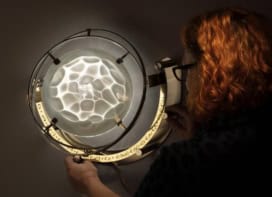Robert P Crease meets a physicist who’s just had his own musical staged in New York City
The house lights slowly dimmed. A dejected-looking man appeared onstage, collapsed on a chair and started to sing: “My work has brought the shadow of death down upon me. I tried to create life, but brought catastrophe.”
Thus began Frankenstein – a new musical whose story, music and lyrics were written by the physicist Eric Sirota, based on Mary Shelley’s 1818 novel of the same name. The forlorn character was Victor Frankenstein (played by Jonathan Cobrda), a scientist whose creation (played by Danny Bristoll) turns on its creator. Frankenstein is currently showing on Mondays at St Luke’s Theatre, a 175-seat Off-Broadway venue in New York City.
Sirota is brave. The ruminations and recollections that animate Shelley’s novel make it difficult to adapt to the stage, and theatre history is replete with unsuccessful Frankenstein productions. Sirota’s version, which I saw on its opening night on 9 October, had problems, including too much exposition and the pantomiming rather than acting out of key events. But it was unpretentious with some excellent singing.
What intrigued me more was the story behind its production. Making it to Off-Broadway takes tenacity and perseverance. How had a working physicist managed it?
In the limelight
A few days after the work opened, I sought out Sirota at ExxonMobil’s research laboratory in Annandale, New Jersey. He showed me one of his third-floor labs, containing rheometers and home-built light-scattering equipment, where he studies the physics of soft materials, particularly waxes, polymers and asphalt (asphaltenes).
Sirota said he had attended Stuyvesant High School in Manhattan. There, he was interested in science and music but never joined the theatre crowd. “My hangout was the computer lab,” he said. He was a physics major at Brown University in Rhode Island, studying music composition and theory in his spare time. In 1980 he went to Harvard University for graduate work in physics.
Only then did Sirota discover the magic of theatre. During a visit home after his first semester, he attended a preview of a play at the Palace Theatre on Broadway. Frankenstein, which cost $2m and was the most expensive Broadway dramatic show to date, was one of its most famous debacles. The show opened and closed on a single night – 4 January 1981 – after terrible reviews. “But it changed my life,” Sirota said. “I heard it sing in my head as a musical. I connected with the story: a scientist, working far from home, the quest for knowledge.”
Sirota’s research, however, left no extracurricular time. He graduated from Harvard in 1986 with a thesis on X-ray studies of soft materials and landed a postdoc at ExxonMobil (then Exxon). He did X-ray scattering at various synchrotron labs, back when such experiments had to be constantly tweaked to get things right and teams of collaborators would work 24 hours a day.
After 1988, when Exxon gave him a permanent position, Sirota “cut back from working 120 hours a week to only 80” and in his spare time began in earnest to complete a musical inspired by Shelley’s novel. When a colleague suggested he stage it with fellow employees, Sirota circulated an enthusiastically received memo. “I didn’t know anything about theatre,” he said, “but I found myself not only the composer/writer, but also the producer.”
Around Halloween 1990 Sirota staged six performances over two weekends in his lab building’s auditorium. It was an amateur production. A retired senior manager took the role of Victor, a polymer chemist Victor’s wife Elizabeth, and a painting contractor the Creature. “I loved the collaborative part of that production as much as I liked science collaborations,” he told me.
Inspired, Sirota sent out inquiry letters, scripts and cassettes to theatres, hoping for a professional staging. “It’s not like, ‘Write it, send it out, see it produced.’ I found it more like, ‘Write it, send it out, get rejected…or just ignored.’ I had a lot to learn about how to write and pitch a musical.”
In 1991 he met a painter named Cara London – on their first date he played her the videotape of his Frankenstein musical – and they married the next year. In the next decade, with a young family to look after, Sirota put his musical equipment in a closet and set aside his dreams of staging Frankenstein. Only in the early 2000s did he begin writing again and in 2006 five pieces of his music were performed at the dedication ceremony of a new building at his synagogue.
It was then that Sirota’s thoughts turned back to full-length musicals. He attended workshops sponsored by theatrical groups, where he learned about crafting musicals, and theatre development and production. He took part in “writer-producer speed-dating” events, at which a dozen or so writers on the inside of a circle pitch projects to as many producers on the outside, and the circles counter-revolve every five minutes. After more rewrites and staged readings – and with next to no preparation time – Sirota’s Frankenstein finally opened in a low-budget production at St Luke’s.
At last Frankenstein wasn’t singing only in his head anymore. Sure, it wasn’t Broadway itself. St Luke’s Theatre is located in an active Lutheran church – it hosts religious services and Bible classes – but also theatre shows that run different days of the week. The show needed work, and Sirota knew it. He attended every performance in the first run to spot things that needed tweaking, scrambling to incorporate them in the next performance, all the while mentally envisioning future theatre projects.
The critical point
In watching Frankenstein, it struck me that there are parallels between collaborations in the theatre and those in science. Both require constant attention, rethinking and reworking before they even begin to work right. Finally, professional apprenticeship is indispensable.




